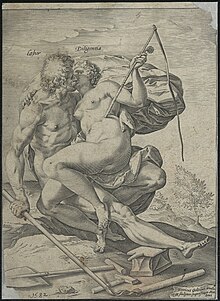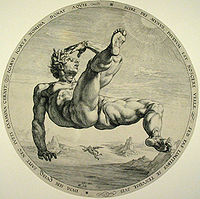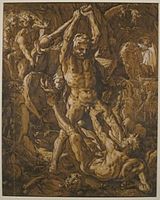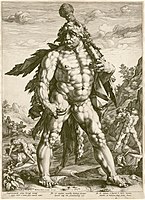Hendrick Goltzius
This article includes a list of general references, but it lacks sufficient corresponding inline citations. (June 2023) |
Hendrick Goltzius | |
|---|---|
painter | |
| Known for | Use of the burin tool for engraving |
| Style | Northern Mannerism |
Hendrick Goltzius, or Hendrik, (German:
Biography



Goltzius was born near
Goltzius had a malformed right hand from a fire when he was a baby (his drawing of it is at right), which turned out to be especially well-suited to holding the burin; "by being forced to draw with the large muscles of his arm and shoulder, he mastered a commanding swing of the line".[4]
In the 1580s, Goltzius with his friends van Mander and the painter Cornelis van Haarlem, founded an art academy in Haarlem in emulation of those in France and Bologna, where the human figure could be studied from life and artists could meet to discuss both practice and aesthetics.[5]
At the age of 21, Goltzius married a widow eight or nine years his senior. Her money enabled him to establish an independent business at Haarlem, but the marriage itself was unhappy. Feeling that the unpleasant atmosphere at home had affected his health, he found it advisable in 1590 to make a tour through Germany to Italy, where he acquired an intense admiration for the works of Michelangelo. He returned to Haarlem in August 1591, considerably improved in health, and worked there until his death.[6]
His portraits, though mostly miniatures, are masterpieces of their kind, both on account of their exquisite finish and as fine studies of individual characters. Of his larger heads, his life-size self-portrait is probably the most striking example.[6]
Goltzius brought to an unprecedented level the use of the "swelling line", where the burin is manipulated to make lines thicker or thinner to create a tonal effect from a distance. He also was a pioneer of the "dot and lozenge" technique, where dots are placed in the middle of lozenge-shaped spaces created by cross-hatching to further refine tonal shading.
Hollstein credits 388 prints to him, with a further 574 by other printmakers after his designs.
In his command of the burin, Goltzius is said to rival
Public collections
Most major print rooms will have a group of Goltzius's many engravings.
- Museum Boijmans Van Beuningen, Rotterdam[7]
- Rijksmuseum Amsterdam[8]
- Blanton Museum of Art, Austin[9]
- University of Michigan Museum of Art, Ann Arbor[10]
- The Metropolitan Museum of Art, New York City[11]
- Philadelphia Museum of Art[12]
- British Museum, London[13]
- Los Angeles County Museum of Art[14]
- Fine Arts Museums of San Francisco[15]
Gallery
-
Horatius Cocles, from The Roman Heroes, 1586
-
Icarus (1588) from the series The four disgracers
-
Engraving of the Farnese Hercules, c. 1598
-
Sine Cerere et Baccho friget Venus (Without Ceres and Bacchus, Venus Would Freeze), 1600–03, Philadelphia Museum of Art
-
Portrait of the Shell Collector Jan Govertsen van der Aer, 1603, Museum Boijmans Van Beuningen
-
Jupiter and Antiope, 1612, National Gallery, London
-
The Fall of Man, 1616, National Gallery of Art, Washington, D.C.
-
Hercules Killing Cacus, achiaroscuro woodcut, 1588
-
Diua Dei genitrix, et cura fielelis Iosepf. Omnia pa fcentem pa feunt hatea fibus efcis., 1589, pen and black ink on laid paper
-
A Foxglove in Bloom, 1592, pen and brown ink on laid paper.
-
The Great Hercules, 1589
Notes
Citations
- ^ Mayor (1971), no. 420
- ^ "Way to Happiness: Work and Diligence". Yale University Library. 1 September 2023.
- ^ "Allegorische voorstelling van de rijkdom en de vlijt". Ghent University Library. Retrieved 2 October 2020.
- ISBN 978-0-226519593– via Google Books.
- JSTOR 23766633.
- ^ a b c Chisholm 1911.
- ^ "Collection: Hendrick Goltzius". Museum Boijmans Van Beuningen. Archived from the original on 22 March 2016. Retrieved 1 September 2014.
- ^ "Hendrick Goltzius". Rijksmuseum.
- ^ "Past Exhibitions, 2003: Prints from the Leo Steinberg Collection, Part 1". Blanton Museum of Art: The University of Texas at Austin. Archived from the original on 22 July 2015. Retrieved 17 July 2015.
- ^ "Hendrick Goltzius". University of Michigan Museum of Art. Retrieved 12 January 2021.
- ^ "Hendrick Goltzius (1558–1617)". Metropolitan Museum of Art. Retrieved 12 January 2021.
- ^ "Collections Object : Landscape with a Waterfall". Philadelphia Museum of Art. Retrieved 12 January 2021.
- ^ "Hendrik Goltzius". British Museum. Retrieved 12 January 2021.
- ^ "Hendrik Goltzius". Los Angeles County Museum of Art. Retrieved 12 January 2021.
- ^ "Hendrick Goltzius". Fine Arts Museums of San Francisco. 21 September 2018. Retrieved 12 January 2021.
References
- This article incorporates text from a publication now in the public domain: Chisholm, Hugh, ed. (1911). "Goltzius, Hendrik". Encyclopædia Britannica. Vol. 12 (11th ed.). Cambridge University Press. p. 227.
- Mayor, A. Hyatt (1971). Prints and People: A Social History of Printed Pictures. New York City: Metropolitan Museum of Art. ISBN 0-691-00326-2.
- Cohn, Marjorie B. (June 2014). "An Interpretation of Four Woodcut Landscapes by Hendrick Goltzius". Print Quarterly. XXXI (2): 144–155.
Further reading
- Liedtke, Walter A. (1984). Flemish paintings in the Metropolitan Museum of Art. New York: The Metropolitan Museum of Art. ISBN 0870993569. (see index).
External links
- "Goltzius, Hendrick". Web Gallery of Art. Retrieved 19 August 2008.
- "Works on Hendrick Goltzius". PubHist.
- "Goltzius engravings: Metamorfosis". Coleccion de Verda.
- "Goltzius engravings: Apóstoles". Coleccion de Verda.











